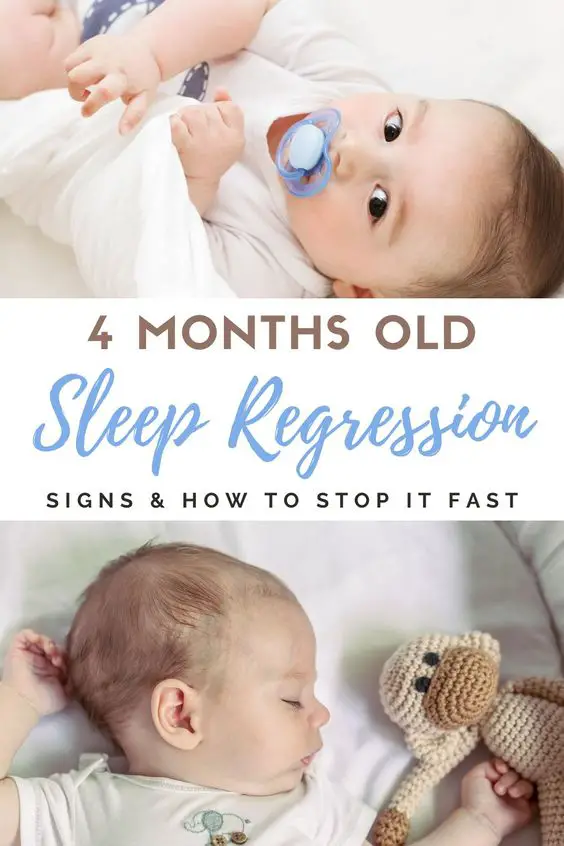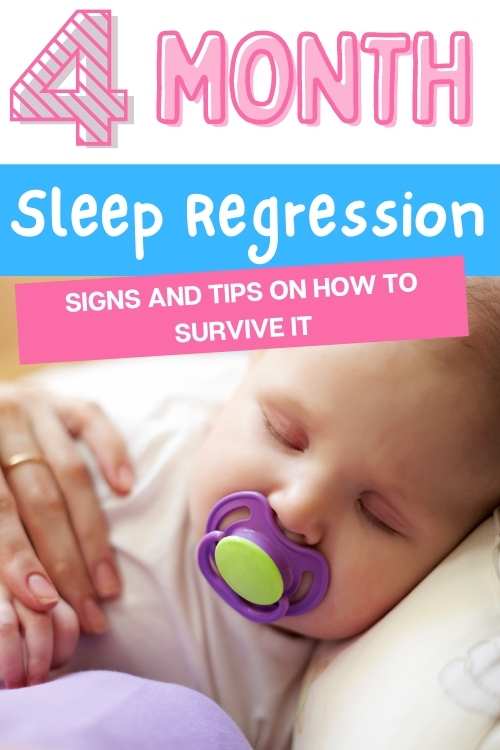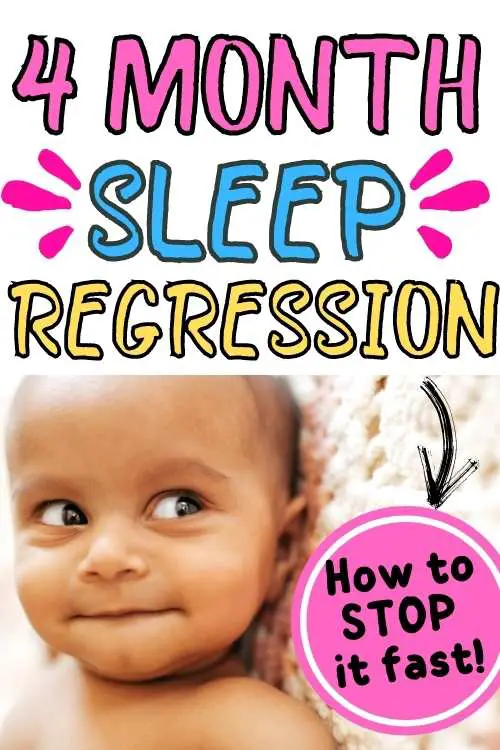If you are reading this post, you’ve probably got a 4 months old baby that just started waking up countless times at night. You might have had a wonderful sleeper up till now, sleeping 7-8 hours a night, and all of a sudden they’re waking up every two hours!
That was exactly me when my second daughter hit the 4 months old milestone. Yep, welcome to the 4 month sleep regression mom: it sucks, I know! 🙂
I thought after the first child I had the sleep thing all covered. Boy was I wrong! The thing is my first baby, didn’t really go through the 4 month sleep regression. She was bottle feeding twice a night, she was happy with the pacifier, and it wasn’t until she was 1 year old that we really struggled with her sleep. But that’s a story for another post!
Michaela on the other hand was the dream sleeper that I was hoping for. Doing 8 hours in a row at night, sleeping for 12 hours in total…. and one day at 4 months she hit the 10 hours in a row. I was all over the moon. I nailed it, I thought.
But let me tell you, that never happened again, at least not for a while! Nor did the 8 hours in a row.
Related: Baby waking up multiple times a night: here’s what you need to know.

What is the 4 Month Sleep Regression
Around 4 months old, the baby’s brain goes through quite a significant development milestone, during which the baby sleep pattern becomes more similar to the one of an adult.
When adults sleep, they cycle through periods of deep sleep and REM sleep (light sleep). Typically, each cycle lasts for about 100 minutes.
Babies also go through a similar cycle with a deeper and lighter sleep. However, babies’ cycle only lasts for about 40-45 minutes during the day (ever wondered why every nap during the day doesn’t often go past the 45 minutes mark? 🙂 ) and about 3 hours at night.
When they reach the 4 months mark, they don’t drift from one cycle to another easily! They actually wake up completely in between each sleep cycle and they need to try go back to sleep by themselves. Their inability to do that is what causes the so called sleep regression.
Babies that are affected by the 4 month sleep regression are usually babies that associate something to them falling asleep, such as the mom feeding them or rocking them, or sucking on a pacifier. I used to feed daughter to sleep every night. I didn’t give her a pacifier at night, but she sure wanted the boob before going to bed, day and night.
After 4 months, when they wake up in between cycles, they won’t be able to go back to sleep unless they have that sleep association again. Meaning you’ll start feeding them every 2 hours at night (yep, that was me!) or you’ll have to get up and put the pacifier back in their mouth.
Why it is important to get it right
The reason why it is so important to tackle the 4 month sleep regression right is that a baby at 4 months old is still young enough not to be too aware of these sleep associations. They will not need or want them so desperately to scream for them for too long.
On the other hand, when the baby reaches the 6 months old mark, they will become way more aware and extremely hard to settle if you don’t give them what soothes them to go to sleep.
So you really want to teach them now (before 6 months) how to “self settle”. Meaning they will learn how to go to sleep (before bedtime and in-between sleep cycles) by themselves without the help of an adult.
And before you close this page thinking: I will never let my baby cry themselves to sleep! Yep, that was me as well! Done that with the first child, never doing it again. Please read a little bit further.
Learning how to “self settle”, doesn’t mean letting your child cry forever until they fall asleep. It just means allowing them to learn this new skill, possibly with the help of other sleep associations that do not involve an adult 🙂

4 Month Sleep Regression: Learning how to Self Settle
Now, if you do this when the baby is still younger than 6 months, I promise it won’t be too hard and it will not take too long. It took my daughter about 4-5 days to learn how to self settle when she was 5 months old. And it was the BEST thing I could possibly do for her.
It is SO easy now to put her to sleep. I just put her down awake in the cot, and she drifts to sleep all by herself without any fuss.
1) New Sleep Associations
The first thing you need to do is try identify and remove that sleep association your baby is relying on to fall asleep. In my daughter’s case, I was either feeding her or rocking her to sleep.
If you are feeding them to sleep, I suggest you start feeding them 15-30 minutes prior to putting them down to bed. If they can only fall asleep with the pacifier, you can either try to get rid of the pacifier, or be patient until they are about 8 months old and they can put the pacifier back in their mouth by themselves. You can find some tips here on how to get rid of the pacifier.
No guarantees though, as my first daughter was still struggling to find the pacifier in the cot at night when she was older! We used to put her to bed with about 4-5 pacifiers in the crib, hoping she could find at least one 🙂
Related: 18 Pacifier Alternatives (for Babies and Toddlers!)
Once you’ve removed that association, I would recommend introducing other associations that don’t involve you. These could be:
- A relaxing bedtime routine: you can try a bath, a massage, a book or a song, for example. The more consistent you are with this routine, the easier it will be for your baby to associate it with sleep.
- A white noise machine: this will create a comfortable environment that calms the baby, helping them to fall asleep faster. Also great to cover up the noise of the toddler running around the house when the baby is sleeping. You know what I mean if you have a toddler and a baby at home! I use the Hushh Portable White Noise Machine, which is awesome. I can also take it with me in the car or in the stroller.
- A teddy or something that your baby can cuddle with: make sure it doesn’t create any suffocation hazard! This or another lovey is also a great one to have if you are transitioning your baby from a bassinet to a crib.

2) Let your baby learn how to fall asleep by themselves
After you’ve established what the new sleep associations are going to be, try start putting your baby to bed when they are still awake, but a bit drowsy from being tired already.
Your baby may start crying at this point because they are not used to falling asleep by themselves. However, at this age it’s usually not such a desperate cry like when they get a bit older. Give them a bit of time to see if they can stop crying and fall asleep.
I suggest you teach them gradually. It will probably take you a few days to get to the point when they don’t cry and just go to sleep. You will still have to pick them up and help them go to sleep at the beginning. But every day try give them a few more minutes to self settle before doing that.
I started with about 1-2 minutes and gradually increased to 4-5 minutes as she stopped crying quite loud. The length to which you want to let them cry really depends on you (every mom is different!) and on the baby. If the cry got intense at any point, I would pick her up no matter on how long it had been since I put her down. You don’t want it to become stressful for either you or the baby 🙂
There’s actually a few gentle sleep training methods that you could try, that involve little to no cry, and I explain them in detail here: 6 Sleep Training Methods that actually work (and don’t involve Cry It Out!)
3) Things to consider
Please keep in mind that when babies are not too tired yet to go to sleep, they may still end up waking a lot at night. The same happens if they are overtired, because the stress hormone builds up and wakes them in between sleep cycles. In both cases, they usually also wake up just 45 minutes after having gone to sleep at night.
Make sure you put your baby down to sleep when they are ready to sleep! Keep an eye on the signs that they are tired, and follow a good day routine. Signs that your baby is tired are:
- Pulling of the ears
- Rubbing the eyes
- Yawning
- Fluttering the eyelids or difficulty focusing
- Arching backwards
- Sucking the fingers
To make sure your baby is getting the right amount of sleep during the day, you can download a FREE sample feeding and sleeping schedule here.
Also know that, between 4 and 6 months, babies become quite hungry! The milk or formula might not fill their tummy enough to get them through the night without feeding. So they might wake up at night because they are genuinely hungry.
It’s completely normal for a 4 months old baby to still need to feed twice a night. And this won’t change until they are well established on solids around 8-9 months. Don’t despair 🙂
If you think your baby is still hungry because you are experiencing a drop in milk supply, then have a look at these solutions on how to fix it, including drinks that can boost your milk supply back up.
Related:

Other Tips for a Good Night Sleep
Here’s other things that you could try at this stage to help your baby have a good night sleep:
1) Sleeping Bag
Put your baby to sleep in a sleeping bag. Try not to use a sheet and blankets at this stage as they are probably rolling, or going to roll pretty soon. so they may end up waking up if they are too cold because they kicked their blanket off.
My favorite one is the Merino Kids Go Go Bag: it is made of merino, which keeps baby cool in summer and warm in winter, so you don’t need to by separate sleeping bags depending on the season. Plus, they have a size 0-2 years, which will last a long time.
- How to Dress Baby for Sleep
- 8 Best Baby Sleeping Bags for Winter (2.5 & 3.5 TOG)
- 10 Best Baby Sleeping Bags for Summer (0.5 & 1 TOG)
2) Dark Room
Keep the room dark. Have black-out curtains or blinds that make the room as dark as possible.
3) Sleep Training
If you are exhausted, sleep deprived and struggling with baby sleeping, and none of the information above seems to help, I would really recommend looking at sleep training and getting the professional help of a sleep consultant.
The older the babies get the harder sleep training becomes, so it’s good to address bad sleeping habits sooner rather than later. I learned this lesson the hard way with my first daughter!
I have put together here a list of gentle sleep training methods that involve little to no crying if you want to have a look. There are also some programs that offer FREE resources.
Related:
- 6 Sleep Training Methods that ACTUALLY work (and that don’t involve Cry It Out!)
- 8 Tips for New Parents to Avoid Sleep Deprivation
4) Follow your Instinct
And the main important thing: follow your instinct and your baby’s cues! No matter what you read or learn, if it’s not working, it might not be the right thing to do for yourself or the baby at that point in time.
The sleep program I followed, for example, only encouraged a 10 minutes sleep in the afternoon at 6 months. Turned out that my second daughter was way too tired at night with just 10 minutes in the afternoon. Once I increased the afternoon sleep to a full sleep cycle of 45 minutes, she started sleeping better at night as well.

Frequently Asked Questions
How long does the 4 month sleep regression last?
This really depends on your baby and on how soon they learn how to self settle! With our first child we didn’t really go through the 4 month sleep regression because she was quite happy with the pacifier. But once she was older, and loosing the pacifier at night, we had to keep getting up to give her the pacifier back. So, depending on what you decide to do, you might get through this one quicker, but be prepared for more to come!
What is the 4 month sleep regression like?
You will notice a drastic change in your baby’s sleeping behavior at night. They usually start waking up as often as every 2 hours, particularly after midnight.
Do all babies go through the 4 month sleep regression?
Not every baby goes through this sleep regression. If the baby was already able to self settle or uses a pacifier to put themselves back to sleep, they might not go through it.
How do you survive the 4 month sleep regression?
Be patient, this too shall pass! 🙂 Follow my suggestions above and talk to a sleep consultant, or go through a baby sleep program.
Does sleep get better after the 4 month regression?
One thing that I learnt about having babies is that the path to improvement is never straight and you’ll go through so many ups and downs, you will stop caring about “when will it get better?” 🙂 It will get better, but then it might get worse again, and so on and so forth, possibly until they are teenagers, who knows. But we’ll all have to face other problems by the time they are 13!
Can you sleep train at 4 months?
If you can teach your child to self settle before 6 months, then I wouldn’t consider this as proper “sleep training”. Things get way more complicated when your child gets older than 6 months. They become much more aware and, if they are not able to go to sleep by themselves, that’s when real sleep training starts.
Is 4 months too early for cry it out?
At 4 months old baby are developmentally ready for you to let them cry a bit to teach them to go to sleep by themselves. And I don’t think the crying of a 4 months old is really desperate like a 6 months old or older . They are not that aware yet, so they will learn relatively easy and quick how to self settle. But you are the only one that can really answer this one properly. Every mom and their reaction to their baby crying is different. You might find this method doesn’t work for you and that’s ok. I really recommend that if you do try it out, do it incrementally! I would only let my baby cry for 1-2 minutes at the beginning, and then increase to 4-5 minutes as she was getting better and learning to self-settle.
How do I teach my baby to self soothe?
Follow my recommendations above and it should be relatively easy to teach your baby to self soothe. It what I wrote above is not enough to help, I suggest you talk to a sleep consultant or go through a baby sleep program.
4 Month Sleep Regression: Final Thoughts
The 4 month sleep regression can be tough, but I am confident with this tips you can get on top of it! And, whatever happens, remember to be consistent with your approach 🙂
If your baby is older than 4 months and still waking up a lot at night, then also check these posts:
- Baby Waking Up Multiple Times a Night: here’s what you need to know
- 6 Month Sleep Regression: Tips on How to Tackle it Fast
- The 8, 9 or 10 Month Sleep Regression: Signs and Tips on How to Survive it
- 6 Sleep Training Methods that ACTUALLY work (and that don’t involve Cry It Out!)
- 18 Pacifier Alternatives (for Babies & Toddlers!)
For some breastfeeding or bottle feeding tips and information:
- 25 Formula & Bottle Feeding Tips (to Make it Easier!)
- Paced Bottle Feeding (Benefits & Tips to do it Right!)
- Sudden Drop in Milk Supply (Signs, Causes & How to Fix it!)
- 20+ Best Online Breastfeeding Courses of 2021 (FREE Classes too!)
- Baby Suddenly Refusing Bottle (Why & 19 Things to Try!)
- Sore Nipples While Breastfeeding?! 15 Tips that Saved Me!
Did you find this helpful? Pin It!



Thanks for sharing this really important tips I would also like to add that soothing audiobooks could also help you better sleep.
Oh how I miss sleeping. My baby is almost 9 months old, and I feel like we still haven’t recovered from the 4 month sleep regression, but we’re getting there. I agree with you that you just have to stick to your guns with it and have a routine. Ours is: get changed, get in sleep sack, put on white noise machine, and brush his teeth. Another tip that has really helped us is to stick to a bedtime and make sure his last nap isn’t too close to that bedtime. I put him in his crib at 7:15 and he can’t nap past 4pm. Wish I found your post 5 months ago 🙂 thanks for sharing!
Hi Rebecca, thanks for the feedback! Agree, I also don’t put my daughter down past a certain time in the afternoon! At the moment she sleeps till 3pm and then goes down at 6.30-7pm. All the best with your little one, you’ll get there ❤️
I wish I had this information when my kids were going through this phase. Mine were terrible. Ugh. I still remember the feeling and they are teens. I am so happy to see so much help out there for these issues. Great information.
Soo question
Maybe just hit 4 moths and defiantly going through sleep regression the funny thing is that he was already learning to self sooth and was putting himself to sleep almost with no cries anymore and now the 4 months hot and boom he’s crying , waking up etc what do I do? ..
Hi Gerda, I think your baby has just become more aware all of a sudden and doesn’t want you to leave him when it’s time to sleep 🙂 4 months is a big developmental milestone! Persist with a good nighttime routine and make sure you don’t introduce new sleep associations (such as rocking or feeding to sleep, etc.) – hopefully the sleep regression will be over in a few days and your baby will be back to normal! xx